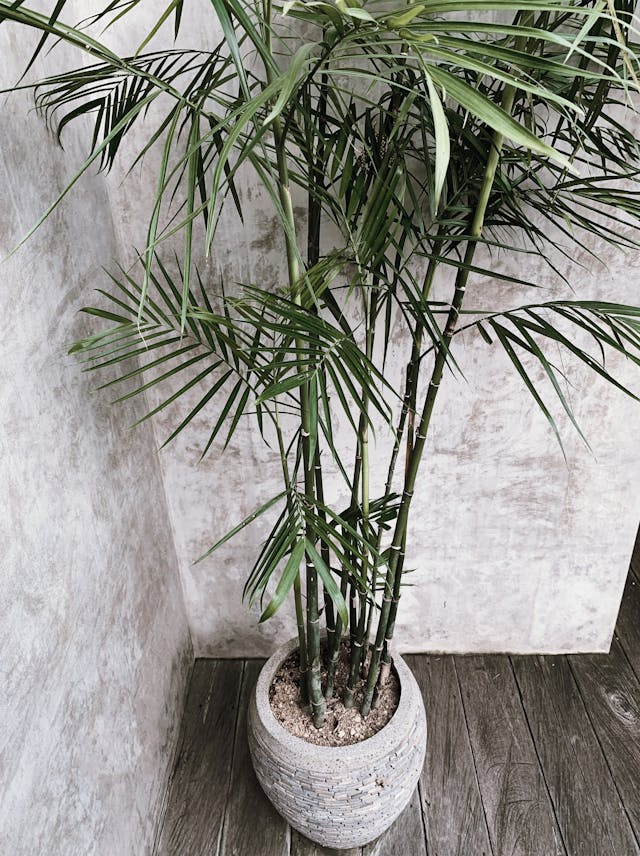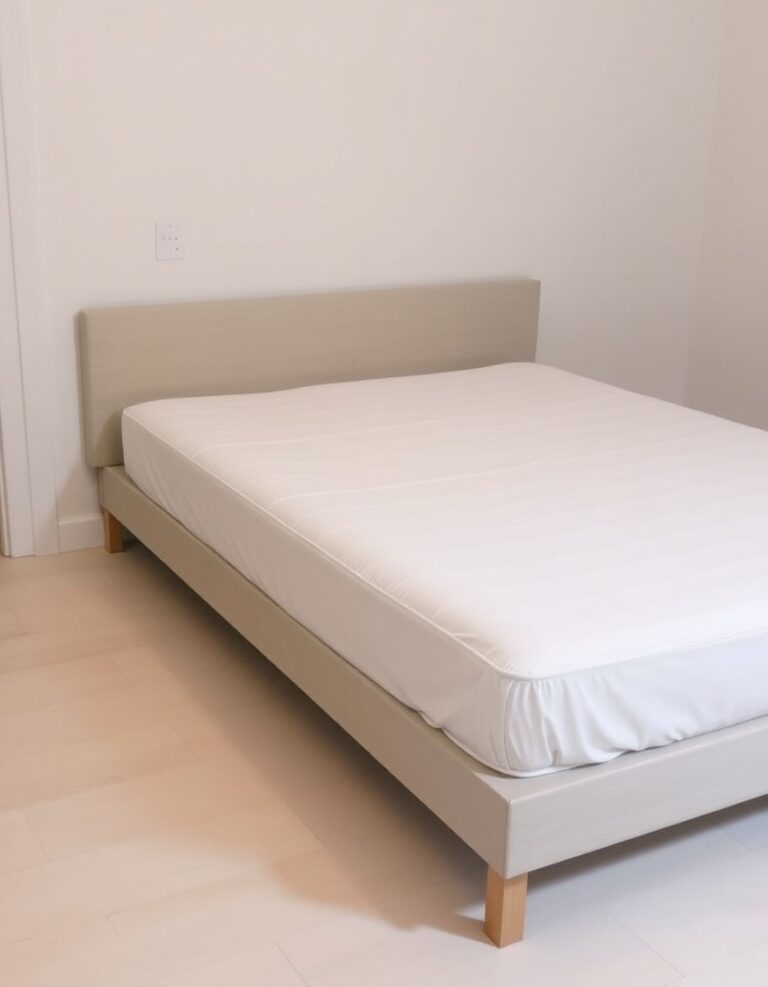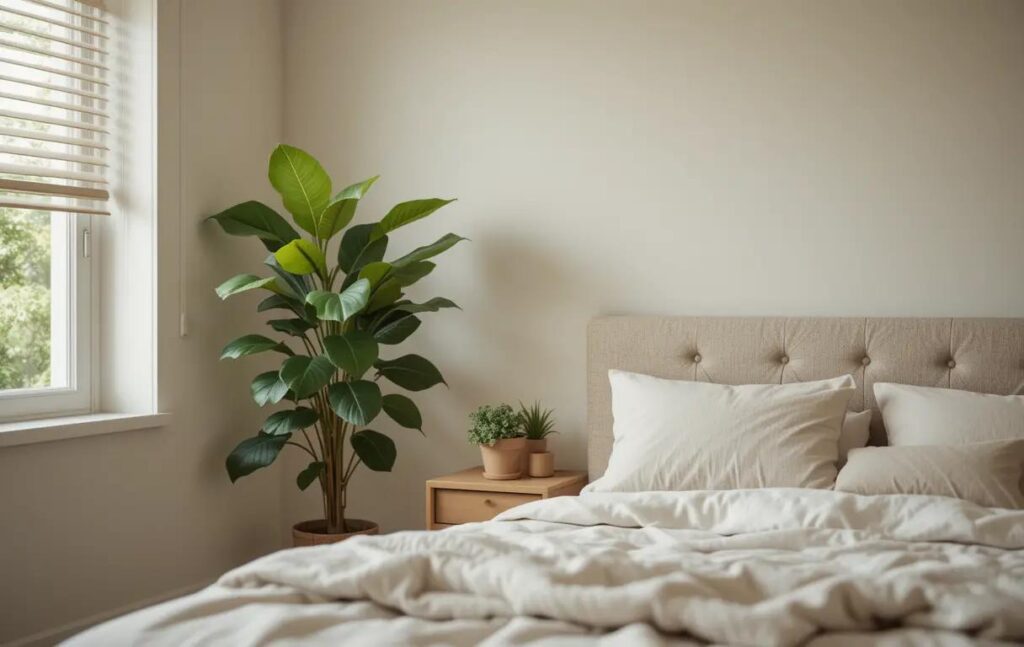
Creating a neutral bedroom means embracing a palette that stands the test of time while delivering both comfort and sophistication. Unlike bold color schemes that may feel overwhelming or trendy choices that quickly date, neutral bedrooms offer a versatile foundation that can evolve with your style preferences.
In this guide, we’ll explore ten thoughtful approaches to designing a neutral bedroom that balances warmth and elegance. From layering textures to incorporating subtle pattern variations, these ideas will help you transform your sleeping space into a refined yet inviting environment.
1. Layer Multiple Textures for Depth

A common misconception about neutral palettes is that they lack visual interest. The solution? Texture layering. In a neutral bedroom, varying textures create dimension without introducing competing colors.
Consider combining:
- Chunky knit throws draped across linen bedding
- Tufted headboards paired with smooth cotton sheets
- Woven baskets alongside polished wood furnishings
- Natural fiber rugs layered over hardwood floors
The contrast between rough and smooth surfaces adds subtle complexity to your neutral bedroom design. For instance, place a nubby wool throw pillow against crisp percale pillowcases, or juxtapose a sleek ceramic lamp against a raw wood nightstand.
2. Introduce Subtle Pattern Variations
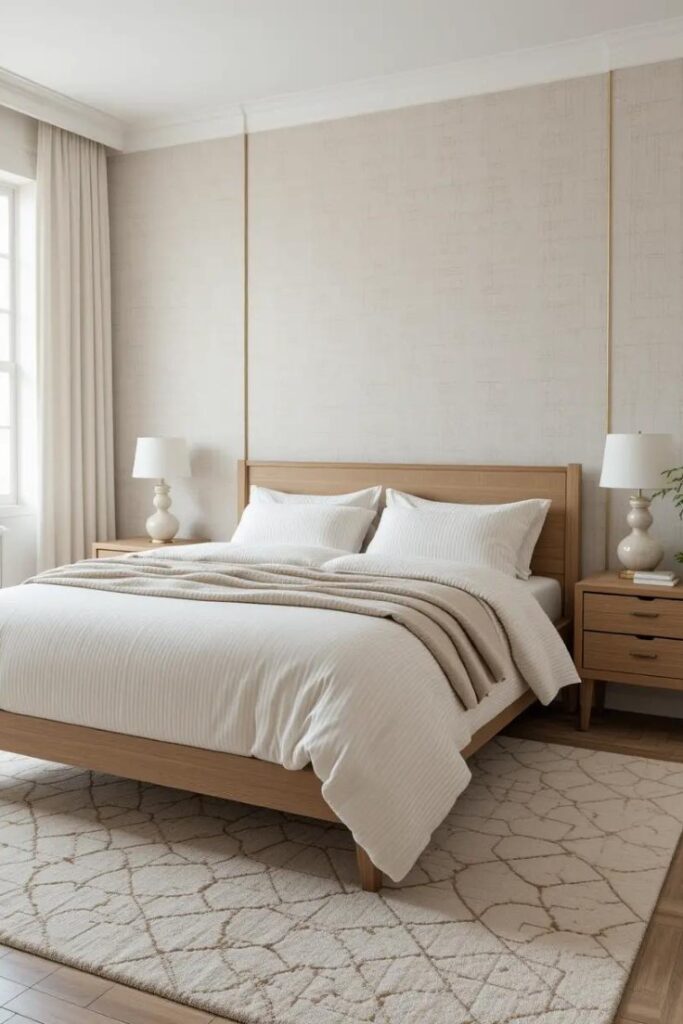
Patterns bring movement to a neutral bedroom without disrupting its calm aesthetic. The key is selecting patterns that incorporate your neutral color scheme rather than introducing new hues.
Effective pattern options include:
- Tone-on-tone striped bedding
- Geometric rugs in coordinating neutrals
- Subtly patterned wallpaper in matching shades
- Natural wood grain variations in furniture pieces
Limit your pattern selection to two or three complementary designs to maintain visual cohesion. Too many competing patterns can negate the serene quality that makes neutral bedrooms so appealing.
3. Incorporate Natural Materials
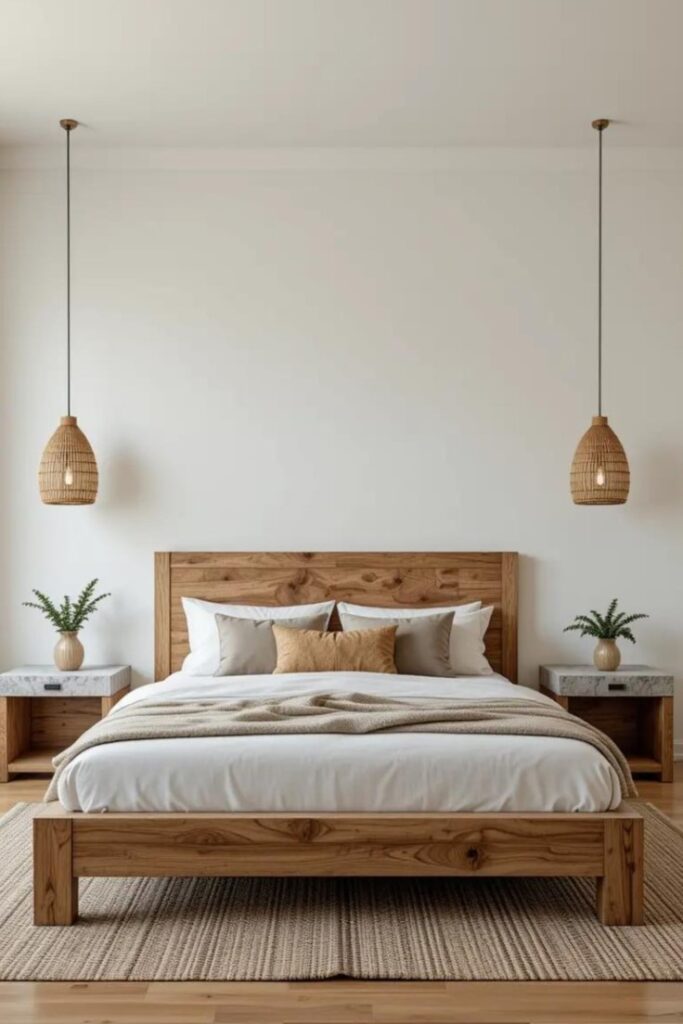
Natural elements infuse warmth into a neutral bedroom while reinforcing the connection to organic color palettes. Materials like wood, stone, rattan, and linen bring authenticity to your space.
Consider these applications:
- Wooden bed frames with visible grain patterns
- Stone-topped bedside tables or dressers
- Rattan pendant lights or headboards
- Linen curtains that filter light beautifully
The subtle variations in natural materials provide inherent visual interest. A solid oak nightstand, for example, contains countless color gradations within its grain pattern, all while remaining within your neutral color story.
4. Create Contrast Through Tonal Variation
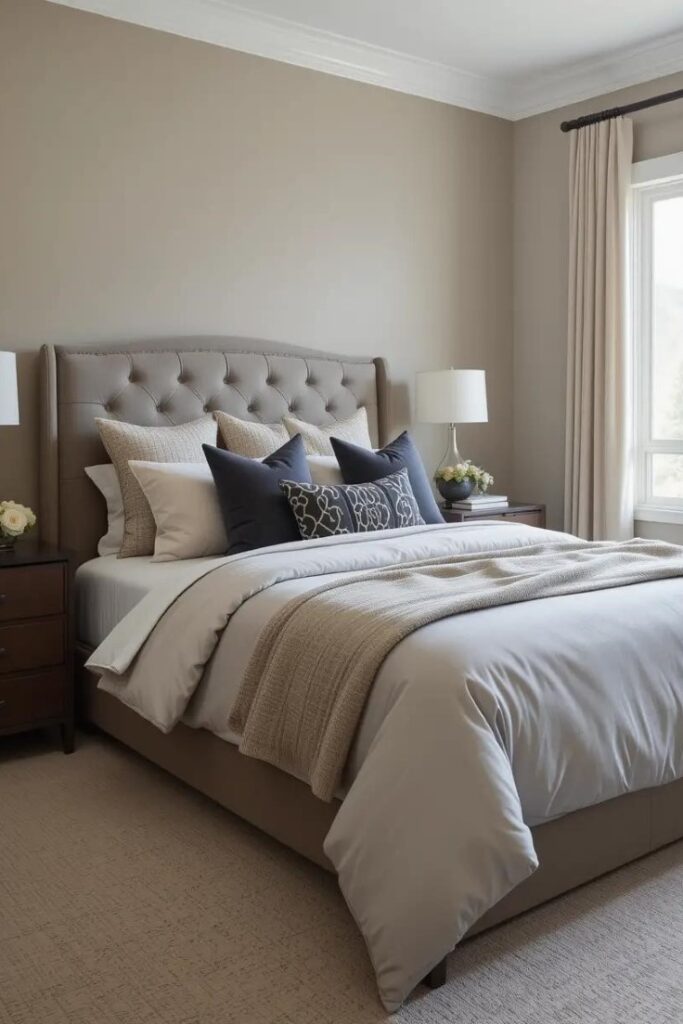
A successful neutral bedroom incorporates varying shades within the same color family. Rather than selecting identical beiges or grays, include lighter and darker tones to create depth.
Effective contrasting elements might include:
- Ivory bedding against taupe walls
- Charcoal accent pillows on a light gray duvet
- Sand-colored curtains paired with creamy trim
- Dark walnut furniture against soft greige carpeting
Tonal contrast creates visual hierarchy in your space, guiding the eye naturally through the room. This technique helps prevent the “flat” appearance that can affect monochromatic spaces.
5. Focus on Thoughtful Lighting Design
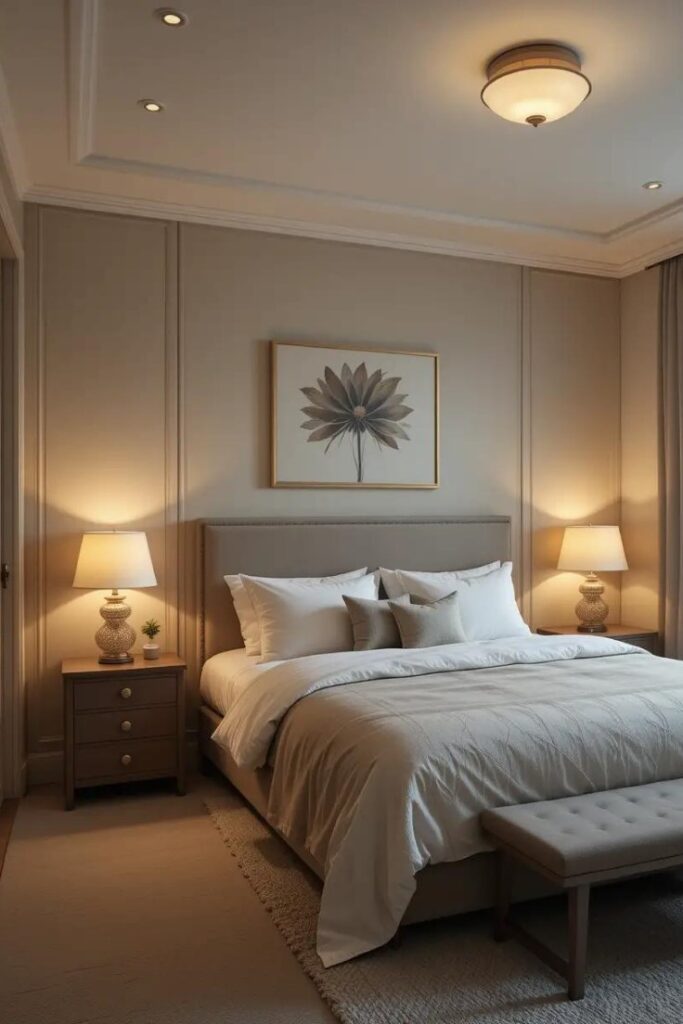
Lighting dramatically impacts how neutral colors read in a space. A neutral bedroom benefits from layered lighting that enhances the subtle color variations.
Consider implementing:
- Warm-toned bedside lamps for evening ambiance
- Ceiling fixtures with dimmers for adjustable overhead light
- Task lighting near dressing areas
- Candles for a soft, golden glow
The color temperature of your lighting fixtures significantly affects neutral palettes. Warm lighting (2700-3000K) tends to enhance cream, beige, and brown tones, while cooler lighting (3500-4000K) often complements gray and blue-based neutrals.
6. Incorporate Minimal Metallic Accents
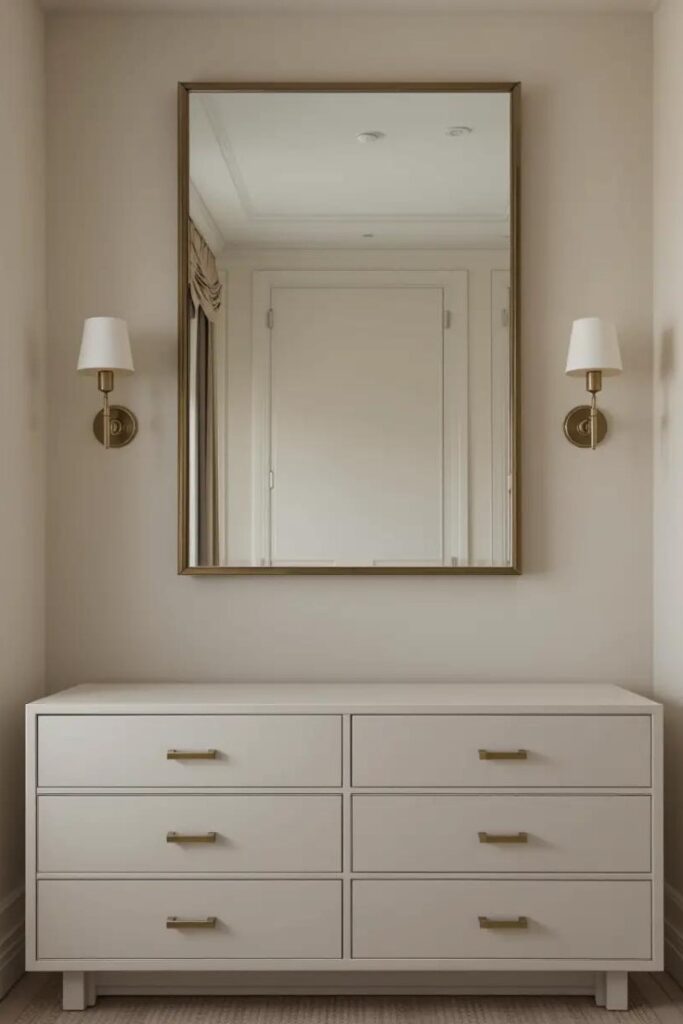
Metallic elements add refined elegance to a neutral bedroom without introducing competing colors. The reflective quality of metals creates subtle highlights throughout the space.
Effective metallic inclusions might be:
- Brass reading lamps or sconces
- Silver-toned drawer pulls
- Bronze mirror frames
- Copper decorative objects
Limit yourself to one primary metal finish throughout the room for cohesion, with perhaps a secondary metal as an accent. This restraint maintains the calm quality of your neutral design scheme.
7. Balance Soft and Structured Elements
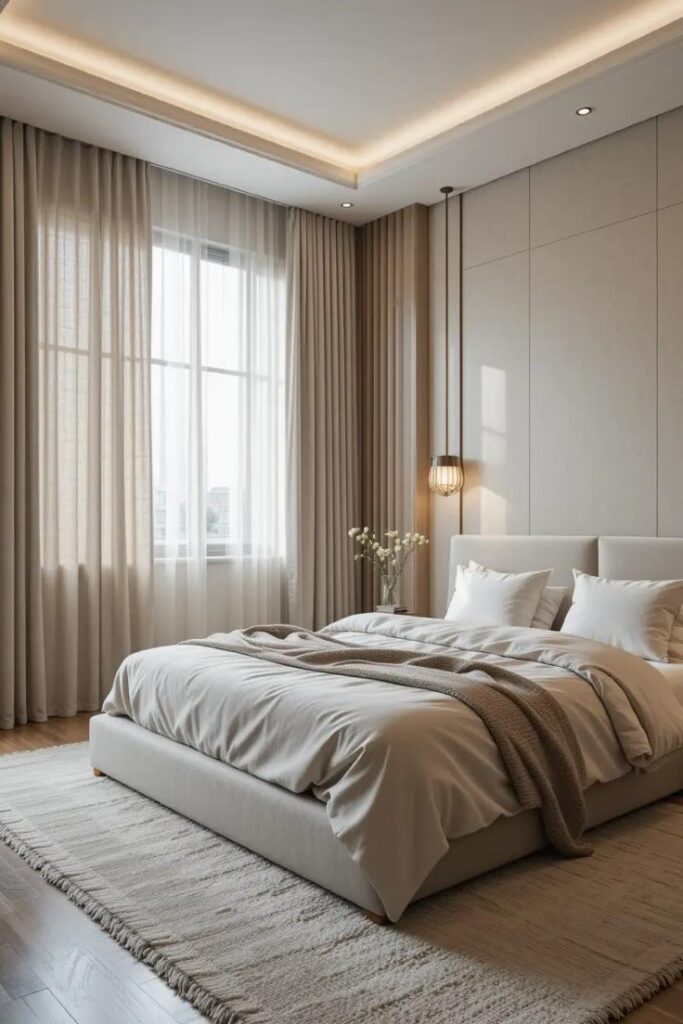
A truly inviting neutral bedroom balances soft, inviting textures with more structured architectural elements. This interplay creates visual interest while maintaining the room’s restful quality.
Consider pairing:
- Plush bedding with a streamlined bed frame
- Soft window treatments with geometric light fixtures
- Rounded decorative pieces with angular furniture
- Draped fabrics with tailored upholstery
This balance of elements prevents a neutral space from feeling either too rigid or overly soft. For example, a structured headboard paired with cloud-like bedding creates a pleasing visual contrast while remaining within your neutral palette.
8. Embrace Negative Space
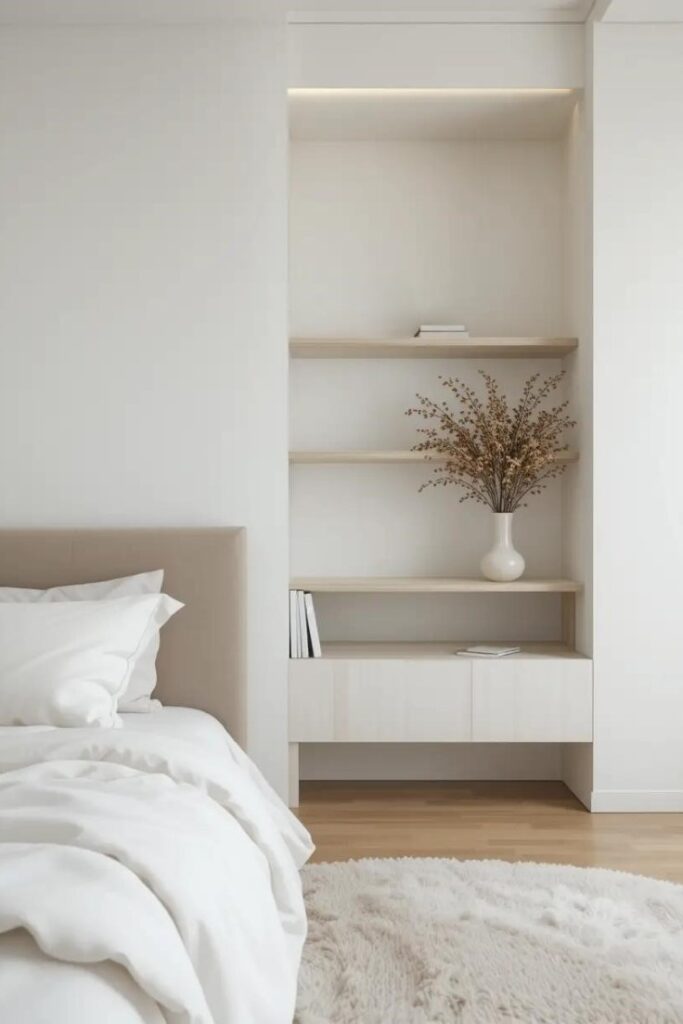
Unlike rooms with bold color schemes, a neutral bedroom benefits from thoughtful negative space. Areas of visual “rest” enhance the serene quality of the design.
Ways to incorporate negative space:
- Allow breathing room between furniture pieces
- Resist overcrowding shelves and surfaces
- Choose larger, statement pieces over multiple small items
- Maintain open areas that enhance room flow
Negative space functions as a design element in neutral rooms, creating balance and preventing visual overload. This approach aligns with minimalist and modern design sensibilities while promoting restfulness.
9. Add Dimension with Wall Treatments
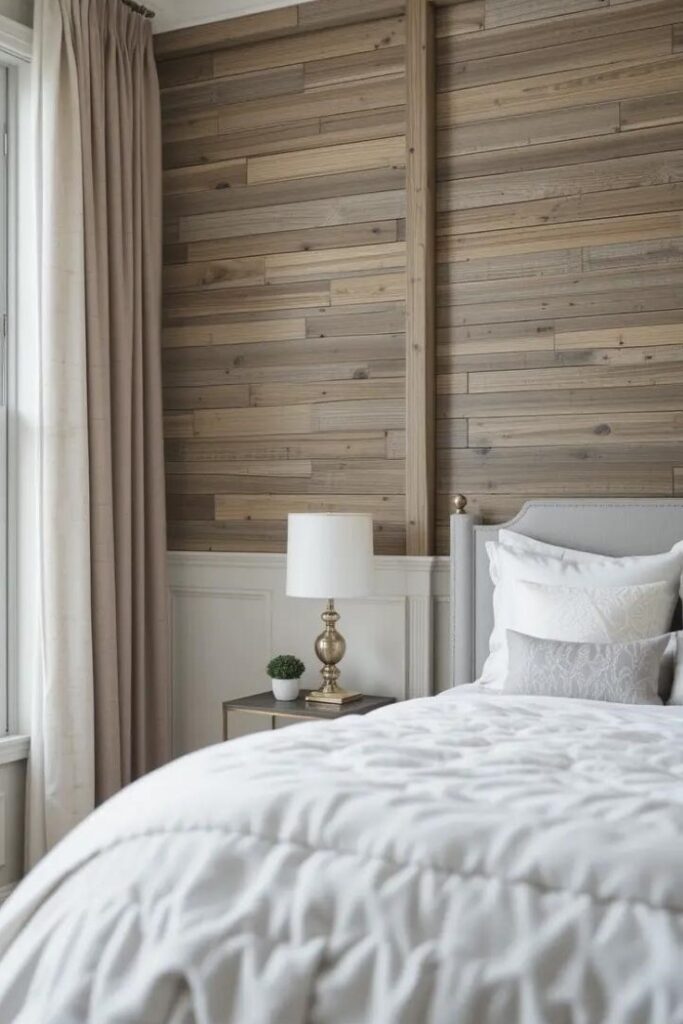
Wall treatments can add significant texture and interest to a neutral bedroom without introducing new colors. These elements create architectural interest that elevates the entire space.
Consider options like:
- Shiplap or board and batten in your wall color
- Textured plaster finishes
- Grasscloth or subtle textured wallpaper
- Tonal wainscoting or paneling
These treatments create shadows and highlights that shift throughout the day, adding dynamic visual interest to your neutral bedroom. For instance, a white shiplap wall contains countless subtle variations as light changes throughout the day.
10. Incorporate Plants for Organic Contrast
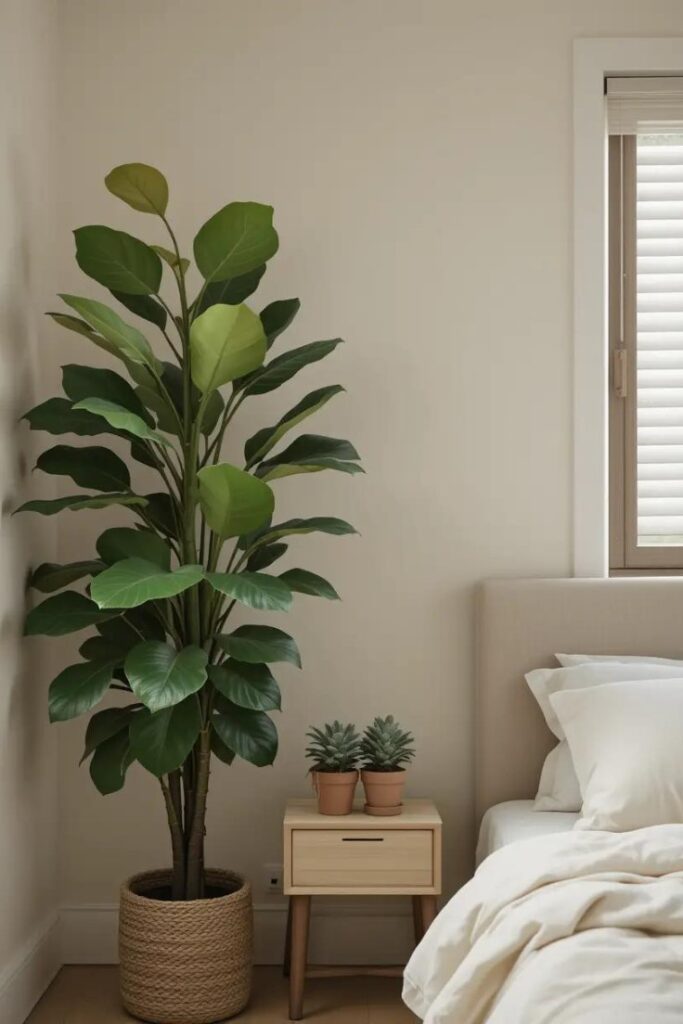
Greenery provides a natural, refreshing element in a neutral bedroom. Plants introduce subtle color variation while reinforcing connections to nature.
Effective plant inclusions might be:
- Tall floor plants in empty corners
- Small potted specimens on nightstands
- Hanging plants near windows
- Dried botanical arrangements in neutral vessels
Select plants with architectural qualities that complement your design aesthetic. A fiddle leaf fig offers dramatic vertical lines, while cascading pothos creates soft, organic movement—both enhancing rather than competing with your neutral palette.
Creating Your Ideal Neutral Bedroom
When designing your neutral bedroom, remember that “neutral” encompasses far more than beige and gray. Consider warm neutrals like camel, taupe, and ivory, or cool neutrals such as slate, pewter, and cream. The success of a neutral design lies in thoughtful layering, textural variation, and attention to subtle details.
Begin by selecting a foundation neutral for your walls and larger furniture pieces, then build interest through varying shades, textures, and complementary materials. This approach creates a neutral bedroom that feels intentional rather than bland.
Focus on quality over quantity in your neutral space. Fewer well-chosen items often create more impact than numerous smaller elements. A beautiful linen duvet, well-proportioned nightstands, and quality window treatments can define your space more effectively than multiple decorative objects.
Remember that a neutral bedroom should reflect your personal design preferences while providing a restful environment. Whether you lean toward warm or cool neutrals, minimalist or more layered designs, the principles outlined above will help you create a space that feels both refined and deeply comfortable.
FAQ: Neutral Bedroom Design
What colors are considered neutral for bedrooms?
Neutral colors include various shades of white, cream, beige, taupe, gray, greige (gray-beige blend), sand, and certain muted earth tones. Both warm neutrals (with yellow or red undertones) and cool neutrals (with blue or green undertones) can work beautifully in a neutral bedroom, depending on your preference and the room’s lighting conditions.
How can I make my neutral bedroom feel cozy instead of cold?
To add warmth to a neutral bedroom, incorporate multiple textures through textiles like chunky knit throws, velvet pillows, and woven elements. Natural materials such as wood and rattan also add warmth. Consider layering rugs, using warm-toned lighting (2700-3000K), and including soft window treatments that filter light beautifully.
What’s the best wall color for a neutral bedroom?
The ideal wall color depends on your space’s lighting and your personal preference for warm versus cool tones. Popular choices include soft white (like Benjamin Moore’s White Dove), warm greige (such as Sherwin Williams Agreeable Gray), or gentle taupe (like Farrow & Ball Elephant’s Breath). Always test paint samples on your actual walls, as lighting significantly affects how neutral colors appear.
How do I add interest to a neutral bedroom without using bright colors?
Create visual interest through textural variation, subtle patterns, architectural details, and tonal contrast. Wall treatments like shiplap or textured wallpaper, statement lighting fixtures, and variations in material finishes all add dimension without introducing bright colors. Plants also provide natural contrast within a neutral palette.
Is it possible to mix warm and cool neutrals in one bedroom?
Yes, mixing warm and cool neutrals can create a sophisticated, layered look. The key is to establish a dominant temperature (either primarily warm or primarily cool) and then incorporate elements of the opposite temperature as accents. For example, a predominantly warm neutral space might include selective cool gray elements for contrast and depth.
How often should I update my neutral bedroom decor?
One advantage of a neutral bedroom is its long-lasting quality. While trend-focused designs may need frequent updating, a well-designed neutral space can remain relevant for many years. Consider refreshing smaller elements like throw pillows, bedding, or decorative objects seasonally if desired, while maintaining your foundational neutral pieces for longevity.


